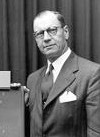-
(b.) -1896(d.)1964 August 09
Bio/Description
A computer scientist for IBM, he was the creator of the Luhn algorithm and KWIC (Key Words In Context) indexing. The Luhn algorithm or Luhn formula, also known as the "modulus 10" or "mod 10" algorithm, is a simple checksum formula used to validate a variety of identification numbers, such as credit card numbers, IMEI numbers, National Provider Identifier numbers in US and Canadian Social Insurance Numbers. It was described in U.S. Patent No. 2,950,048, filed on January 6, 1954, and granted on August 23, 1960. He was awarded over 80 patents. It is not intended to be a cryptographically secure hash function; it was designed to protect against accidental errors, not malicious attacks. Most credit cards and many government identification numbers use the algorithm as a simple method of distinguishing valid numbers from mistyped or otherwise incorrect numbers. He was born in Barmen, Germany (now part of Wuppertal). After he completed secondary school, he moved to Switzerland to learn the printing trade so he could join the family business. His career in printing was halted by his service as a communications officer in the German Army during World War I. After the war, he entered the textile field, which eventually led him to the United States, where he invented a threadcounting gauge (the Lunometer) still on the market. From the late twenties to the early forties, during which time he obtained patents for a broad range of inventions, he worked in textiles and as an independent engineering consultant. He joined IBM as a Senior Research Engineer in 1941, and soon became manager of the Information Retrieval Research Division. His introduction to the field of documentation/information science came in 1947 when he was asked to work on a problem brought to IBM by James Perry and Malcolm Dyson that involved searching for chemical compounds recorded in coded form. He came up with a solution for that and other problems using punched cards, but often had to overcome the limitations of the available machines by coming up with new ways of using them. By the dawn of the computer age in the 1950s, software became the means to surmount the limitations inherent in the punched card machines of the past. He spent greater and greater amounts of time on the problems of information retrieval and storage faced by libraries and documentation centers, and pioneered the use of data processing equipment in resolving these problems. It is said, "He was the first, or among the first, to work out many of the basic techniques now commonplace in information science." These techniques included full-text processing; hash codes; Key Word in Context indexing (see also Herbert Marvin Ohlman); auto-indexing; automatic abstracting and the concept of selective dissemination of information (SDI). Two of his greatest achievements are the idea for an SDI system and the KWIC method of indexing. Today's SDI systems owe a great deal to a 1958 paper by him, "A Business Intelligence System", which described an "automatic method to provide current awareness services to scientists and engineers" who needed help to cope with the rapid post-war growth of scientific and technical literature. He apparently coined the term business intelligence in that paper.
-
Date of Birth:
1896 -
Date of Death:
1964 August 09 -
Noted For:
Creator of the Luhn algorithm and KWIC (Key Words In Context) indexing used to validate a variety of identification numbers, such as credit card numbers, etc. and is in wide use today -
Category of Achievement:
-
More Info:


